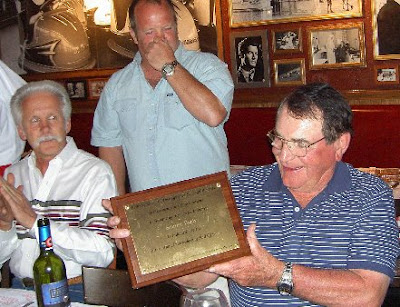 Dr. Mike Steward of Shawnee, Oklahoma developed a simple, inexpensive and effective shoeing treatment for laminitis by making a "Steward Clog" out of plywood. Photo by Andrew Knittle, The Shawnee News-Star.
Dr. Mike Steward of Shawnee, Oklahoma developed a simple, inexpensive and effective shoeing treatment for laminitis by making a "Steward Clog" out of plywood. Photo by Andrew Knittle, The Shawnee News-Star.Tomorrow night the town of Saratoga Springs, New York is going to hear all about clog shoes for laminitis. And have a good time doing it. The Hoofcare@Saratoga series will welcome Dr Michael Steward to be the first speaker of 2009, as we kickoff the year at the National Museum of Racing.
Whether you are planning to come or not, here's a chance to download a great article. "Going Dutch" by Holly Clanahan won second place in the American Horse Publications Awards last month for articles published in 2008. The article is about Dr. Michael Steward of Shawnee, Oklahoma and his clog shoe for laminitis.
AQHA graciously timed the first-ever release of a free download of the article to coincide with Dr. Steward's trip to speak in Saratoga. But this article can and will benefit plenty of horses, owners, veterinarians, and farriers who have never heard of Saratoga or Shawnee.
Click here to initiate the download process on the AQHA web site. Thanks to the AQHA for their help with this, and for the exposure they have given to Dr. Steward and his simple, cost-effective treatment. Yes, many of his cases are Quarter horses but this treatment has now been adopted and adapted (for better or worse) by many levels of farriers and veterinarians and is being used on all sorts of cases.
Tomorrow night we will be celebrating the shoes and boots that are on display in the National Museum of Racing lobby exhibit this summer. Among them is what looks like a stray piece of plywood that the exhibit fabricator left behind. That's the Steward Clog. It will be a pleasure to show Dr Steward his shoe in the Museum's collection.
 The right foot of this horse is wearing a Steward Clog held in place with deck screws. Casting tape will stabilize the hoof wall and the appliance.
The right foot of this horse is wearing a Steward Clog held in place with deck screws. Casting tape will stabilize the hoof wall and the appliance.The original way--the simple clog--still works and would be a great, cost-effective technique for equine rescue farms to master. I hope they'll be in the audience Tuesday night, along with everyone who cares about real-world laminitis.
I hope we can work toward a day when "lack of funds" will no longer have to be written as the cause of death on a foundered horse's medical record. And I thank Dr Steward and everyone else who is trying to help work toward that day.
© Fran Jurga and Hoofcare Publishing. No use without permission. You only need to ask.
Fran Jurga's Hoof Blog is a between-issues news service for subscribers to Hoofcare and Lameness Journal. This blog may be read online at the blog page, checked via RSS feed, or received via a digest-type email (requires signup in box at top right of blog page).
To subscribe to Hoofcare and Lameness (the journal), please visit the main site, www.hoofcare.com, where many educational products and media related to equine lameness and hoof science can be found.
Questions or problems with this blog? Send email to blog@hoofcare.com.







